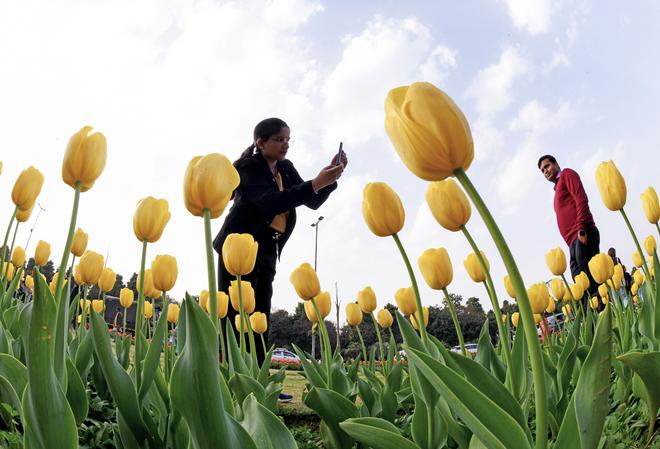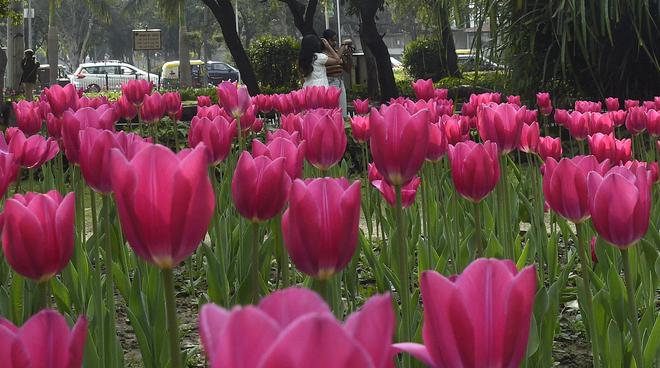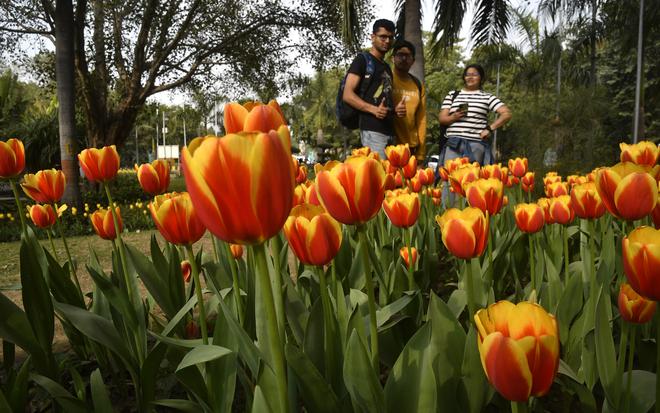Over the past week, pictures of Delhi’s tulips in bloom have been shared across social media and WhatsApp groups. City residents passing by Shantipath in the diplomatic enclave, runners’ haunt Nehru Park, and Lodhi Garden where history and modernity meet, have all marvelled at the sight.
In a bid to fulfil Lieutenant Governor V.K. Saxena’s promise when he took charge in May 2022, to make Delhi a “City of joy, city of flowers”, three lakh tulip bulbs were imported from the Netherlands in December 2023: two lakh for NDMC-governed areas and one lakh for the Delhi Development Authority (DDA, which they paid for).

According to NDMC sources, the cost of a single tulip bulb was between ₹25 and ₹30, with a total approved cost of ₹87 lakh, of the ₹120.69 crore NDMC horticulture budget for 2023-24. This is the second year of tulip plantation in the city.
Along with other gardeners, Raju (name changed to protect privacy), 43, was trained by NDMC’s horticulture department in the art of raising tulips in the national capital. For the past two years, he has treated the bulbs with care, transferring them from the Tulip Growth Cum Storage Chamber established at Lodhi Garden to flower beds in Central Delhi, where the most prominent government offices are.

“NDMC has taken extensive care to ensure the tulips survive in Delhi despite them not being indigenously found in the city,” Mr. Raju said, beaming, as he gently watered the plants. The gardener explained that tulip care did not end with planting. Since they have become crowd pullers, inviting hundreds of people every day, staffers have been tasked with ensuring no one pulls at them. Officials also made routine visits to ensure their well-being.
Shankar, (name changed), 37, has been posted as a security guard on the Shantipath lawns. He works in eight-hour shifts along with two or three other security personnel, reprimanding any visitor who ‘disturbs’ the tulips. “They are very expensive; NDMC has given us strict instructions to make sure that nothing happens to them,” he said, admitting that it was getting tiring to tell people all day long not to touch the flowers. On February 13, a motorcyclist was caught and reported to the police for attempting to pluck tulips from the lawns.

Reshma Verma, 59, a homemaker, drove almost 20 km, for her grandson to see the tulips. She said, “The fascination for these flowers came from the many reels I saw on Instagram. If our government is taking such initiatives and making the city beautiful by adding foreign flowers, it is our responsibility to support them.” Many Delhi-ites, inspired by last year’s tulip displays, have been inspired to try their hand at growing the flowers at home too.
The tulips are available in eight colours: white, black, yellow, red, yellow-red, pink, orange, and purple. The Lodhi Garden facility can store about 50,000 tulip bulbs, NDMC sources said. Sources explained that around 2,000 bulbs of 8-10 cm size had been harvested from NDMC areas last year after the tulips bloomed in February-March. They were stored in the chamber between 15 and 20 degrees Celsius for three months. Thereafter, they were kept under temperatures of 5-6 degrees Celsius for 10 weeks, to escape Delhi’s summer that hits 40 degrees Celsius and above.

Pradip Krishen, an environmentalist, naturalist, and author of Trees of Delhi: A Field Guide, explained that since tulips bloom for a very short period, they would probably not have long-term impacts on the environment of Delhi, despite being vilayati (foreign). However, he says it is akin to raising a polar bear in the capital: “One can obviously attempt to do so with modern technology, but that does not mean one should.” He added that many countries had rules to support and promote indigenous flora and fauna. “Previously, Delhi’s authorities tried to plant species such as chinar and cherry in the capital but the plants did not survive.”







